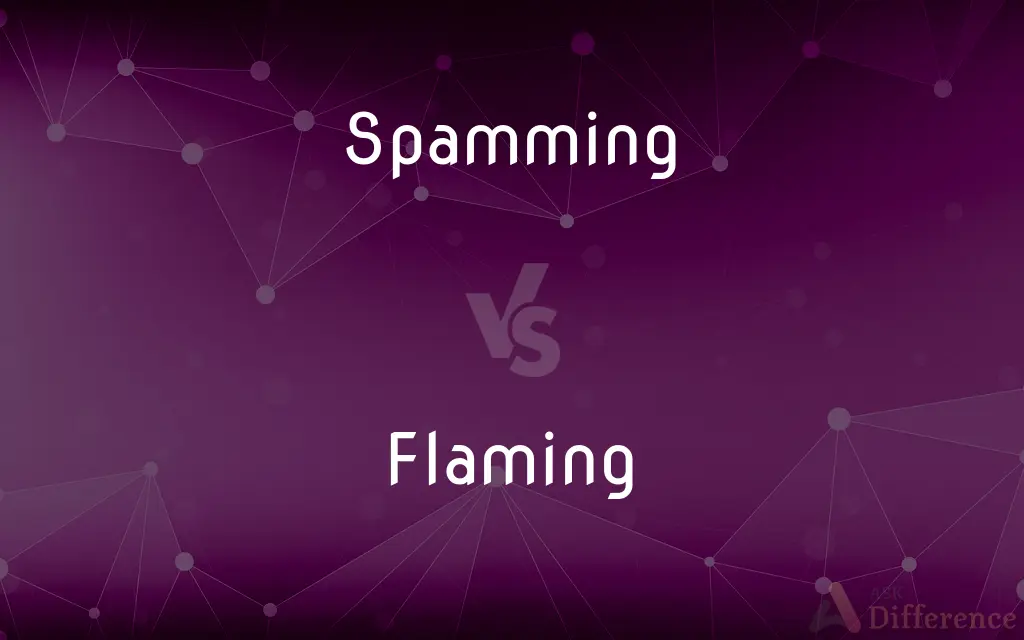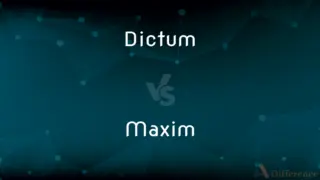Spamming vs. Flaming — What's the Difference?
By Tayyaba Rehman & Urooj Arif — Updated on April 5, 2024
Spamming involves repeatedly sending unsolicited messages to annoy or advertise, while flaming is the act of posting hostile messages online to provoke or insult.

Difference Between Spamming and Flaming
Table of Contents
ADVERTISEMENT
Key Differences
Spamming is characterized by the repetitive sending of unsolicited messages, often for advertising purposes or to disrupt online conversations. On the other hand, flaming involves posting deliberately hostile or insulting messages in online forums, social media, or chat rooms, usually to provoke a reaction or express anger.
While spamming is generally automated and can target a wide audience without discrimination, flaming is typically targeted and reflects personal conflict or aggressive disputes between individuals or groups online. This distinction highlights the impersonal nature of spamming versus the personal aggression of flaming.
Spamming can disrupt the user experience by cluttering inboxes or forums with irrelevant or repetitive content, making it harder for users to find valuable information. Flaming, however, directly impacts the online community's tone, often leading to heated arguments, toxicity, and a deteriorating sense of community.
Techniques to combat spamming include filters, blocklists, and verification processes designed to limit the reach of unsolicited messages. In contrast, addressing flaming often requires moderation and community management efforts, such as enforcing rules of conduct, to maintain a respectful and constructive online environment.
The motivations behind spamming are often commercial gain or to spread malware, whereas flaming is driven by emotions, such as anger or the desire to dominate a conversation. This reflects a fundamental difference in the objectives behind each action, with spamming focused on reach and impact, while flaming is about expression and reaction.
ADVERTISEMENT
Comparison Chart
Definition
Sending unsolicited messages repeatedly
Posting hostile messages to provoke or insult
Primary Motivation
Commercial gain, disruption
Emotional expression, provocation
Target
Broad, indiscriminate
Specific individuals or groups
Impact
Clutters communication channels, disrupts user experience
Deteriorates community atmosphere, provokes arguments
Mitigation Strategies
Filters, blocklists, verification
Community moderation, rules of conduct
Compare with Definitions
Spamming
Sending bulk unsolicited messages, often for advertising.
His inbox was flooded with spamming from various online stores.
Flaming
Involves aggressive communication and hostility.
He regretted his flaming outburst in the chat room.
Spamming
Often involves promotional or irrelevant content.
The comment section was filled with spamming about unrelated products.
Flaming
Posting messages to provoke or insult others online.
The online debate escalated into flaming, making it unpleasant.
Spamming
Unsolicited, automated messages over email or messaging platforms.
She used a filter to block spamming on her email.
Flaming
Aimed at attacking or demeaning someone.
The forum's flaming posts were eventually removed by moderators.
Spamming
Can be a tactic to overload or disrupt services.
The website was temporarily down due to spamming attacks.
Flaming
Can lead to online arguments and toxicity.
What started as a disagreement turned into a full-blown flaming war.
Spamming
Repeatedly posting the same message in online forums.
The forum thread was overrun with spamming, burying meaningful discussions.
Flaming
Reflects personal conflict or emotion.
Her flaming response was out of frustration with the ongoing issue.
Spamming
Unsolicited email, often of a commercial nature, sent indiscriminately to multiple mailing lists, individuals, or newsgroups; junk email.
Flaming
Intense; ardent
Flaming passions.
Spamming
Spamming is the use of messaging systems to send multiple unsolicited messages (spam) to large numbers of recipients for the purpose of commercial advertising, for the purpose of non-commercial proselytizing, for any prohibited purpose (especially the fraudulent purpose of phishing), or simply sending the same message over and over to the same user. While the most widely recognized form of spam is email spam, the term is applied to similar abuses in other media: instant messaging spam, Usenet newsgroup spam, Web search engine spam, spam in blogs, wiki spam, online classified ads spam, mobile phone messaging spam, Internet forum spam, junk fax transmissions, social spam, spam mobile apps, television advertising and file sharing spam.
Flaming
On fire; ablaze.
Spamming
A single piece of such email
"receiving dozens of spams a day" (George Johnson).
Flaming
Resembling a flame in brilliance, color, or form
Flaming autumn leaves.
Spamming
To send unsolicited email to.
Flaming
(Informal) Used as an intensive
A flaming liberal.
Spamming
To send (a message) indiscriminately to multiple mailing lists, individuals, or newsgroups.
Flaming
On fire with visible flames.
The flaming debris kept the firefighter well back, and the sparks threatened the neighborhood.
Spamming
Present participle of spam
Flaming
Very bright and the color of flame.
Spamming
(internet) The act of sending unwanted electronic mail.
Flaming
Very enthusiastic or passionate.
Flaming
Present participle of flame
Flaming
An emission or application of fire; act of burning with flames.
Flaming
Sterilization by holding an object in a hot flame.
Flaming
(internet slang) Vitriolic criticism.
You can expect a flaming if you post irrelevant spam to a newsgroup.
Flaming
Emitting flames; afire; blazing; consuming; illuminating.
Flaming
Of the color of flame; high-colored; brilliant; dazzling.
Flaming
Ardent; passionate; burning with zeal; irrepressibly earnest; as, a flaming proclomation or harangue.
Flaming
The process of combustion of inflammable materials producing heat and light and (often) smoke;
Fire was one of our ancestors' first discoveries
Flaming
Resembling flame in brilliance or color;
Maple trees ablaze in autumn
Flaming autumn leaves
Flaming
Lighted up by or as by fire or flame;
Forests set ablaze (or afire) by lightning
Even the car's tires were aflame
A night aflare with fireworks
Candles alight on the tables
Blazing logs in the fireplace
A burning cigarette
A flaming crackling fire
Houses on fire
Flaming
Very intense;
A fiery temper
Flaming passions
Common Curiosities
What is spamming?
Spamming is the act of sending unsolicited messages en masse, often for advertising purposes or to disrupt communication.
What is flaming?
Flaming is the posting of hostile or insulting messages online, aimed at provoking or attacking others.
How do spamming and flaming differ in intent?
Spamming is primarily driven by commercial interests or the desire to disrupt, while flaming is motivated by emotional expression or the intent to provoke.
Do spammers target specific individuals?
Spammers typically target a wide audience indiscriminately, unlike flaming, which is more targeted.
Can flaming occur in any online setting?
Yes, flaming can occur in any online setting where users interact, including forums, social media, and chat rooms.
Is flaming always negative?
Yes, flaming is considered negative as it involves hostility and insults, contributing to online toxicity.
How can spamming be prevented?
Spamming can be mitigated with the use of filters, blocklists, and verification processes to limit unsolicited messages.
What measures can be taken against flaming?
Flaming can be addressed through community moderation, implementing and enforcing rules of conduct to maintain a respectful online environment.
Do both spamming and flaming require technical skills?
Spamming often requires some technical skills to automate messages, whereas flaming is more about the content of messages and requires no specific technical skills.
Does flaming have any positive aspects?
While flaming is generally seen as negative, some argue it can bring attention to issues or injustices, though there are more constructive ways to do so.
Can spamming be automated?
Yes, spamming is often automated, using bots to send bulk messages across various platforms.
Is spamming illegal?
In many jurisdictions, certain forms of spamming, especially via email, are regulated or illegal, depending on the content and method used.
Can someone be banned for spamming or flaming?
Yes, individuals can be banned from platforms or forums for spamming or flaming, as these actions violate most online communities' rules.
How does flaming affect online communities?
Flaming can significantly affect online communities by fostering a hostile environment, discouraging participation, and leading to a decline in constructive discussion.
Can the impact of spamming and flaming be minimized?
Yes, through a combination of technical solutions, community management, and user education, the impacts of spamming and flaming can be minimized.
Share Your Discovery

Previous Comparison
Samael vs. Lucifer
Next Comparison
Dictum vs. MaximAuthor Spotlight
Written by
Tayyaba RehmanTayyaba Rehman is a distinguished writer, currently serving as a primary contributor to askdifference.com. As a researcher in semantics and etymology, Tayyaba's passion for the complexity of languages and their distinctions has found a perfect home on the platform. Tayyaba delves into the intricacies of language, distinguishing between commonly confused words and phrases, thereby providing clarity for readers worldwide.
Co-written by
Urooj ArifUrooj is a skilled content writer at Ask Difference, known for her exceptional ability to simplify complex topics into engaging and informative content. With a passion for research and a flair for clear, concise writing, she consistently delivers articles that resonate with our diverse audience.















































